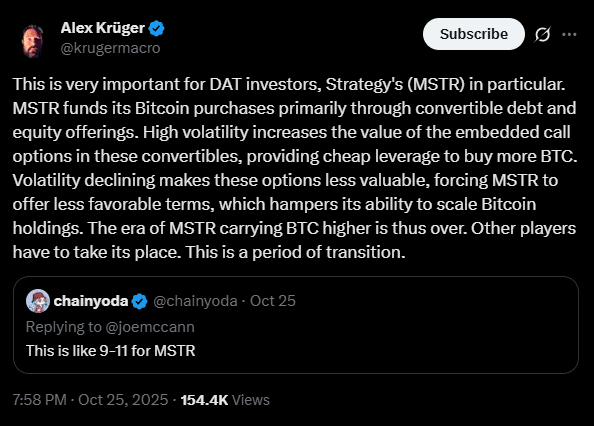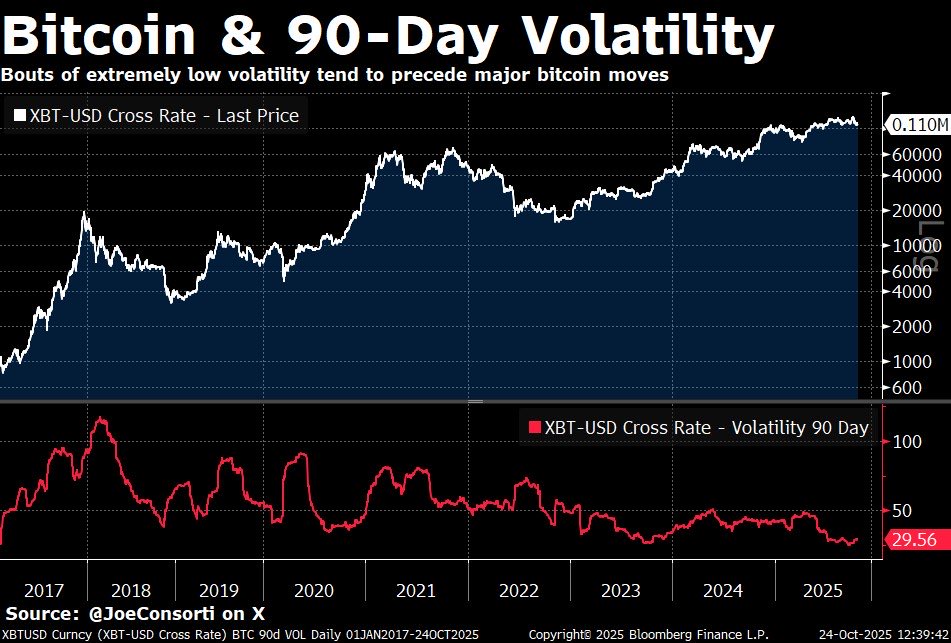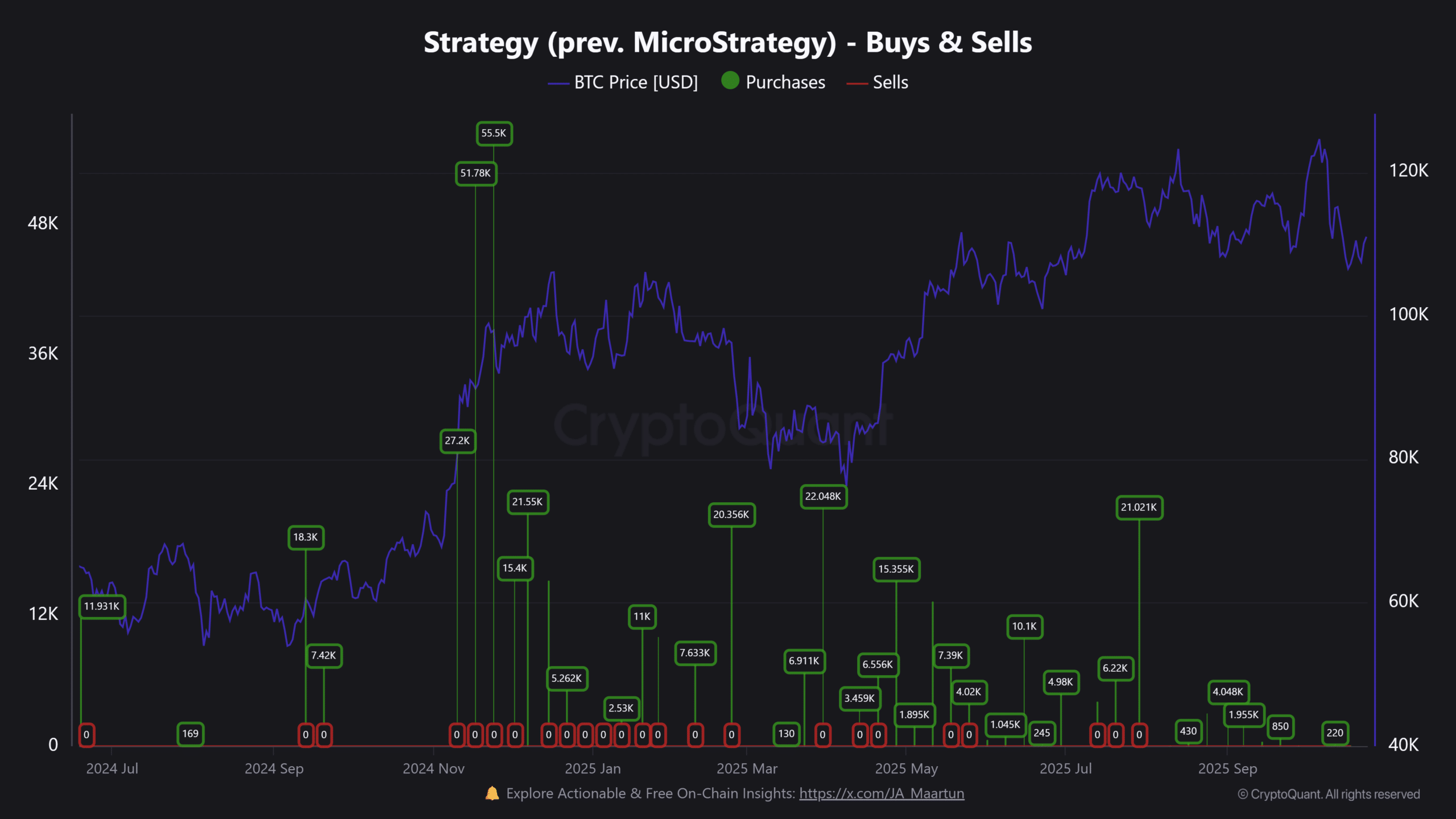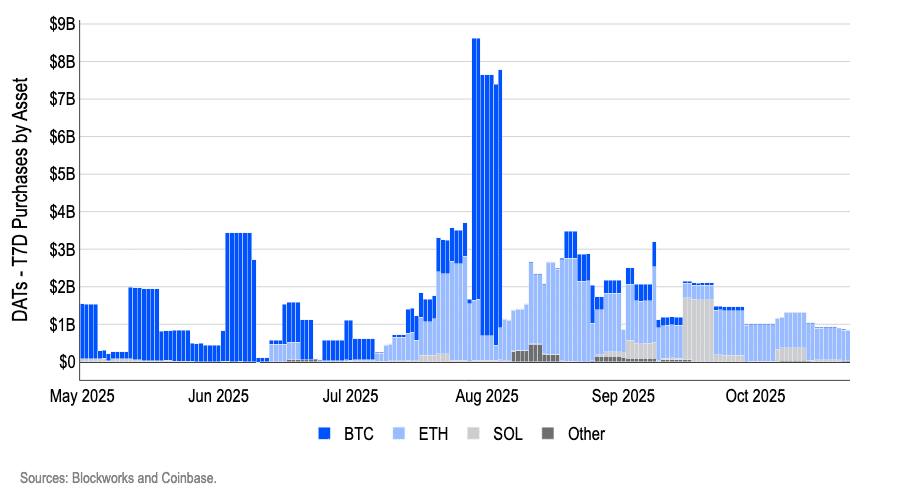| COINOTAG recommends • Exchange signup |
| 💹 Trade with pro tools |
| Fast execution, robust charts, clean risk controls. |
| 👉 Open account → |
| COINOTAG recommends • Exchange signup |
| 🚀 Smooth orders, clear control |
| Advanced order types and market depth in one view. |
| 👉 Create account → |
| COINOTAG recommends • Exchange signup |
| 📈 Clarity in volatile markets |
| Plan entries & exits, manage positions with discipline. |
| 👉 Sign up → |
| COINOTAG recommends • Exchange signup |
| ⚡ Speed, depth, reliability |
| Execute confidently when timing matters. |
| 👉 Open account → |
| COINOTAG recommends • Exchange signup |
| 🧭 A focused workflow for traders |
| Alerts, watchlists, and a repeatable process. |
| 👉 Get started → |
| COINOTAG recommends • Exchange signup |
| ✅ Data‑driven decisions |
| Focus on process—not noise. |
| 👉 Sign up → |
Bitcoin’s declining volatility in 2025 is hindering MicroStrategy’s (now Strategy) ability to raise capital via convertible debt for BTC purchases, as lower price swings reduce the value of embedded options, potentially stalling their aggressive accumulation strategy and impacting short-term BTC demand.
-
Reduced volatility lowers the appeal of convertible debt for Strategy, limiting cheap leverage for buying more Bitcoin.
-
Institutional adoption through ETFs and corporate treasuries is driving this stability, altering traditional market dynamics.
-
Coinbase analysts note a 17 billion dollar retail loss tied to digital asset treasury companies, signaling short-term caution for BTC at support levels around 111.6K.
Discover how Bitcoin’s low volatility in 2025 challenges Michael Saylor’s Strategy BTC strategy. Explore impacts on accumulation and market demand—read now for key insights on crypto stability.
How is Bitcoin’s low volatility affecting MicroStrategy’s Strategy?
Bitcoin’s low volatility is creating challenges for MicroStrategy’s rebranded entity, Strategy, by diminishing the effectiveness of its primary funding mechanism for Bitcoin acquisitions. As the 90-Day Volatility Index hits record lows in 2025, the value of call options embedded in convertible debt decreases, making it harder for Strategy to secure favorable terms for raising capital. This shift could slow their Bitcoin buying momentum, which has been a significant driver of market demand since the asset’s major rally earlier in the year.
| COINOTAG recommends • Professional traders group |
| 💎 Join a professional trading community |
| Work with senior traders, research‑backed setups, and risk‑first frameworks. |
| 👉 Join the group → |
| COINOTAG recommends • Professional traders group |
| 📊 Transparent performance, real process |
| Spot strategies with documented months of triple‑digit runs during strong trends; futures plans use defined R:R and sizing. |
| 👉 Get access → |
| COINOTAG recommends • Professional traders group |
| 🧭 Research → Plan → Execute |
| Daily levels, watchlists, and post‑trade reviews to build consistency. |
| 👉 Join now → |
| COINOTAG recommends • Professional traders group |
| 🛡️ Risk comes first |
| Sizing methods, invalidation rules, and R‑multiples baked into every plan. |
| 👉 Start today → |
| COINOTAG recommends • Professional traders group |
| 🧠 Learn the “why” behind each trade |
| Live breakdowns, playbooks, and framework‑first education. |
| 👉 Join the group → |
| COINOTAG recommends • Professional traders group |
| 🚀 Insider • APEX • INNER CIRCLE |
| Choose the depth you need—tools, coaching, and member rooms. |
| 👉 Explore tiers → |
What role does institutionalization play in Bitcoin’s reduced volatility?
The ongoing institutionalization of Bitcoin, fueled by the influx of exchange-traded funds (ETFs) and corporate treasury allocations, is a key factor behind the asset’s subdued price movements. According to market observers, this maturation process stabilizes the market by increasing liquidity and reducing erratic swings that were common in earlier cycles. For instance, data from on-chain analytics platforms indicate that ETF inflows have averaged substantial volumes monthly, absorbing supply and tempering volatility.
Analyst Alex Kruger has highlighted how this trend directly impacts leveraged strategies like Strategy’s. He explains, “Volatility declining makes these options embedded in convertible debt less valuable, forcing MSTR to offer less favorable terms, which hampers its ability to scale Bitcoin holdings.” This perspective underscores the broader implications for corporate adopters relying on financial instruments tied to BTC’s price fluctuations.
| COINOTAG recommends • Exchange signup |
| 📈 Clear interface, precise orders |
| Sharp entries & exits with actionable alerts. |
| 👉 Create free account → |
| COINOTAG recommends • Exchange signup |
| 🧠 Smarter tools. Better decisions. |
| Depth analytics and risk features in one view. |
| 👉 Sign up → |
| COINOTAG recommends • Exchange signup |
| 🎯 Take control of entries & exits |
| Set alerts, define stops, execute consistently. |
| 👉 Open account → |
| COINOTAG recommends • Exchange signup |
| 🛠️ From idea to execution |
| Turn setups into plans with practical order types. |
| 👉 Join now → |
| COINOTAG recommends • Exchange signup |
| 📋 Trade your plan |
| Watchlists and routing that support focus. |
| 👉 Get started → |
| COINOTAG recommends • Exchange signup |
| 📊 Precision without the noise |
| Data‑first workflows for active traders. |
| 👉 Sign up → |
Supporting data from volatility charts shows the 90-day metric dipping below historical averages, a phenomenon linked to over 20% of institutional portfolios now including digital assets, as reported by financial research firms. Short sentences like this facilitate quick scanning: the result is a more predictable but less opportunistic environment for aggressive accumulation.

| COINOTAG recommends • Traders club |
| ⚡ Futures with discipline |
| Defined R:R, pre‑set invalidation, execution checklists. |
| 👉 Join the club → |
| COINOTAG recommends • Traders club |
| 🎯 Spot strategies that compound |
| Momentum & accumulation frameworks managed with clear risk. |
| 👉 Get access → |
| COINOTAG recommends • Traders club |
| 🏛️ APEX tier for serious traders |
| Deep dives, analyst Q&A, and accountability sprints. |
| 👉 Explore APEX → |
| COINOTAG recommends • Traders club |
| 📈 Real‑time market structure |
| Key levels, liquidity zones, and actionable context. |
| 👉 Join now → |
| COINOTAG recommends • Traders club |
| 🔔 Smart alerts, not noise |
| Context‑rich notifications tied to plans and risk—never hype. |
| 👉 Get access → |
| COINOTAG recommends • Traders club |
| 🤝 Peer review & coaching |
| Hands‑on feedback that sharpens execution and risk control. |
| 👉 Join the club → |
Source: X
Furthermore, Kruger’s assessment that the “era of MSTR carrying BTC higher is over” reflects a consensus among experts that Strategy’s influence on price may wane without high volatility to amplify its leverage. Historically, Strategy has used convertible debt and equity offerings to fund purchases, capitalizing on volatile periods where options gained premium value, enabling cost-effective BTC accumulation.
In contrast, the current low-volatility regime reverses this dynamic, potentially pushing Strategy toward more expensive equity dilutions. The firm’s market net asset value (mNAV) has compressed to 1.1X, and a further drop below 1 could severely restrict stock-based fundraising. This scenario might effectively pause Strategy’s Bitcoin buying spree, which slowed notably in the second half of the year following a 21K overhaul in July.

| COINOTAG recommends • Exchange signup |
| 📈 Clear control for futures |
| Sizing, stops, and scenario planning tools. |
| 👉 Open futures account → |
| COINOTAG recommends • Exchange signup |
| 🧩 Structure your futures trades |
| Define entries & exits with advanced orders. |
| 👉 Sign up → |
| COINOTAG recommends • Exchange signup |
| 🛡️ Control volatility |
| Automate alerts and manage positions with discipline. |
| 👉 Get started → |
| COINOTAG recommends • Exchange signup |
| ⚙️ Execution you can rely on |
| Fast routing and meaningful depth insights. |
| 👉 Create account → |
| COINOTAG recommends • Exchange signup |
| 📒 Plan. Execute. Review. |
| Frameworks for consistent decision‑making. |
| 👉 Join now → |
| COINOTAG recommends • Exchange signup |
| 🧩 Choose clarity over complexity |
| Actionable, pro‑grade tools—no fluff. |
| 👉 Open account → |

Source: X
| COINOTAG recommends • Members‑only research |
| 📌 Curated setups, clearly explained |
| Entry, invalidation, targets, and R:R defined before execution. |
| 👉 Get access → |
| COINOTAG recommends • Members‑only research |
| 🧠 Data‑led decision making |
| Technical + flow + context synthesized into actionable plans. |
| 👉 Join now → |
| COINOTAG recommends • Members‑only research |
| 🧱 Consistency over hype |
| Repeatable rules, realistic expectations, and a calmer mindset. |
| 👉 Get access → |
| COINOTAG recommends • Members‑only research |
| 🕒 Patience is an edge |
| Wait for confirmation and manage risk with checklists. |
| 👉 Join now → |
| COINOTAG recommends • Members‑only research |
| 💼 Professional mentorship |
| Guidance from seasoned traders and structured feedback loops. |
| 👉 Get access → |
| COINOTAG recommends • Members‑only research |
| 🧮 Track • Review • Improve |
| Documented PnL tracking and post‑mortems to accelerate learning. |
| 👉 Join now → |
Market data reinforces this: Bitcoin’s price has stabilized around key support levels, but without the volatility premium, Strategy’s playbook is constrained. Experts from Coinbase have echoed these concerns, pointing to broader demand patterns in the ecosystem.
Frequently Asked Questions
How might Strategy’s stalled accumulation influence Bitcoin’s price trajectory?
As one of the largest corporate buyers, Strategy’s reduced purchasing activity could exert downward pressure on Bitcoin’s price in the short term, especially amid absent demand from other digital asset treasury companies. Coinbase analysts estimate this could prolong consolidation around current levels, with potential dips if ETF inflows also moderate, based on recent on-chain trends showing a 17 billion dollar retail impact.
| COINOTAG recommends • Exchange signup |
| 🎯 Focus on process over noise |
| Plan trades, size positions, execute consistently. |
| 👉 Sign up → |
| COINOTAG recommends • Exchange signup |
| 🛠️ Simplify execution |
| Keep decisions clear with practical controls. |
| 👉 Get started → |
| COINOTAG recommends • Exchange signup |
| 📊 Make data your edge |
| Use depth and alerts to avoid guesswork. |
| 👉 Open account → |
| COINOTAG recommends • Exchange signup |
| 🧭 Be prepared, not reactive |
| Turn setups into rules before you trade. |
| 👉 Create account → |
| COINOTAG recommends • Exchange signup |
| ✍️ Plan first, then act |
| Entries, exits, and reviews that fit your routine. |
| 👉 Join now → |
| COINOTAG recommends • Exchange signup |
| 🧩 Consistency beats intensity |
| Small, repeatable steps win the long run. |
| 👉 Sign up → |
What factors are contributing to the absence of DAT buying for Bitcoin right now?
Digital asset treasury companies, or DATs, have sidelined their Bitcoin buying due to post-leverage washout caution, as noted by Coinbase. This follows significant demand in August, marginal activity in September, and near-total absence in October, highlighting fragility when major players pause at support levels like 111.6K, ahead of macro events such as Fed decisions.
Key Takeaways
- Declining Bitcoin volatility challenges Strategy’s leverage: Lower swings devalue convertible debt options, limiting cost-effective BTC accumulation.
- Institutional factors stabilize the market: ETFs and corporate treasuries reduce price extremes, but this hampers opportunistic buying strategies like MicroStrategy’s.
- Short-term BTC risks from DAT slowdown: With 17 billion in retail losses and no major buying, investors should monitor macro updates for potential volatility spikes.

| COINOTAG recommends • Premium trading community |
| 🏛️ WAGMI CAPITAL — Premium Trading Community |
| Strategic insights, exclusive opportunities, professional support. |
| 👉 Join WAGMI CAPITAL → |
| COINOTAG recommends • Premium trading community |
| 💬 Inner Circle access |
| See members share real‑time PnL and execution notes in chat. |
| 👉 Apply for Inner Circle → |
| COINOTAG recommends • Premium trading community |
| 🧩 Turn theses into trades |
| Reusable templates for entries, risk, and review—end to end. |
| 👉 Join the club → |
| COINOTAG recommends • Premium trading community |
| 💡 Long‑term mindset |
| Patience and discipline over noise; a process that compounds. |
| 👉 Get started → |
| COINOTAG recommends • Premium trading community |
| 📚 Education + execution |
| Courses, playbooks, and live market walkthroughs—learn by doing. |
| 👉 Get access → |
| COINOTAG recommends • Premium trading community |
| 🔒 Members‑only research drops |
| Curated analyses and private briefings—quality over quantity. |
| 👉 Join WAGMI CAPITAL → |
Source: CryptoQuant
DAT demand fades as Strategy’s accumulation stalls
The demand from digital asset treasury companies for Bitcoin has notably weakened over the past two weeks, contributing to a cautious market outlook. Coinbase analysts observe that this absence, concentrated elsewhere like Ethereum, underscores hesitation among large holders following recent leverage events.
| COINOTAG recommends • Exchange signup |
| 🧱 Execute with discipline |
| Watchlists, alerts, and flexible order control. |
| 👉 Sign up → |
| COINOTAG recommends • Exchange signup |
| 🧩 Keep your strategy simple |
| Clear rules and repeatable steps. |
| 👉 Open account → |
| COINOTAG recommends • Exchange signup |
| 🧠 Stay objective |
| Let data—not emotion—drive actions. |
| 👉 Get started → |
| COINOTAG recommends • Exchange signup |
| ⏱️ Trade when it makes sense |
| Your plan sets the timing—not the feed. |
| 👉 Join now → |
| COINOTAG recommends • Exchange signup |
| 🌿 A calm plan for busy markets |
| Set size and stops first, then execute. |
| 👉 Create account → |
| COINOTAG recommends • Exchange signup |
| 🧱 Your framework. Your rules. |
| Design entries/exits that fit your routine. |
| 👉 Sign up → |
“DAT buying hasn’t shown up for BTC and is narrowly concentrated for ETH, which highlights some caution from large players post leverage washout, even at current ‘support’ levels,” they stated. Charts from analytics platforms reveal robust DAT bids in August, tapering in September, and vanishing in October, correlating with substantial retail losses exceeding 17 billion dollars.


Source: Coinbase
As a primary demand source alongside ETFs, the DAT retreat poses risks to Bitcoin’s recovery. Analysts from Coinbase add, “We think this warrants more cautious positioning in the short term, because the market appears more fragile when the biggest discretionary balance sheets are sidelined.” At the time of reporting, Bitcoin traded at 111.6K, with upcoming events like the Federal Reserve rate decision and U.S.-China tariff discussions potentially influencing future volatility.

Conclusion
Bitcoin’s low volatility in 2025, driven by institutional adoption, is reshaping strategies for major players like Michael Saylor’s Strategy, potentially curbing their Bitcoin accumulation through less viable convertible debt options. As DAT demand fades and market fragility emerges, short-term caution prevails for BTC holders. Looking ahead, monitoring macro developments could signal renewed volatility and opportunities in the evolving crypto landscape—stay informed to navigate these shifts effectively.
| COINOTAG recommends • Members‑only research |
| 📌 Curated setups, clearly explained |
| Entry, invalidation, targets, and R:R defined before execution. |
| 👉 Get access → |
| COINOTAG recommends • Members‑only research |
| 🧠 Data‑led decision making |
| Technical + flow + context synthesized into actionable plans. |
| 👉 Join now → |
| COINOTAG recommends • Members‑only research |
| 🧱 Consistency over hype |
| Repeatable rules, realistic expectations, and a calmer mindset. |
| 👉 Get access → |
| COINOTAG recommends • Members‑only research |
| 🕒 Patience is an edge |
| Wait for confirmation and manage risk with checklists. |
| 👉 Join now → |
| COINOTAG recommends • Members‑only research |
| 💼 Professional mentorship |
| Guidance from seasoned traders and structured feedback loops. |
| 👉 Get access → |
| COINOTAG recommends • Members‑only research |
| 🧮 Track • Review • Improve |
| Documented PnL tracking and post‑mortems to accelerate learning. |
| 👉 Join now → |













